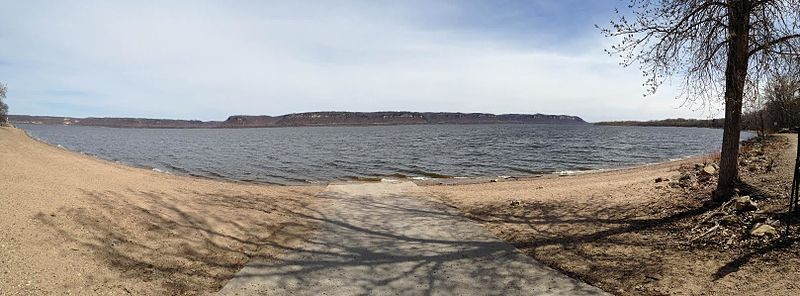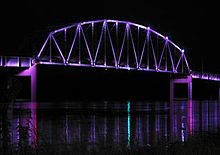Cultural geography

State boundaries
The Mississippi River runs through or along 10 states, from Minnesota to Louisiana, and is used to define portions of these states borders, with Wisconsin, Illinois, Kentucky, Tennessee, and Mississippi along the east side of the river, and Iowa, Missouri, and Arkansas along its west side. Substantial parts of both Minnesota and Louisiana are on either side of the river, although the Mississippi defines part of the boundary of each of these states.
In all of these cases, the middle of the riverbed at the time the borders were established was used as the line to define the borders between adjacent states. In various areas, the river has since shifted, but the state borders have not changed, still following the former bed of the Mississippi River as of their establishment, leaving several small isolated areas of one state across the new river channel, contiguous with the adjacent state. Also, due to a meander in the river, a small part of western Kentucky is contiguous with Tennessee, but isolated from the rest of its state.
Communities along the river
| Metro Area | Population |
|---|---|
| Minneapolis–Saint Paul | 3,946,533 |
| St. Louis | 2,916,447 |
| Memphis | 1,316,100 |
| New Orleans | 1,214,932 |
| Baton Rouge | 802,484 |
| Quad Cities, IA-IL | 387,630 |
| St. Cloud, MN | 189,148 |
| La Crosse, WI | 133,365 |
| Cape Girardeau–Jackson MO-IL | 96,275 |
| Dubuque, IA | 93,653 |
Many of the communities along the Mississippi River are listed below; most have either historic significance or cultural lore connecting them to the river. They are sequenced from the source of the river to its end.
Bridge crossings
The road crossing highest on the Upper Mississippi is a simple steel culvert, through which the river (locally named "Nicolet Creek") flows north from Lake Nicolet under "Wilderness Road" to the West Arm of Lake Itasca, within Itasca State Park.
The earliest bridge across the Mississippi River was built in 1855. It spanned the river in Minneapolis where the current Hennepin Avenue Bridge is located. No highway or railroad tunnels cross under the Mississippi River.
The first railroad bridge across the Mississippi was built in 1856. It spanned the river between the Rock Island Arsenal in Illinois and Davenport, Iowa. Steamboat captains of the day, fearful of competition from the railroads, considered the new bridge a hazard to navigation. Two weeks after the bridge opened, the steamboat Effie Afton rammed part of the bridge, setting it on fire. Legal proceedings ensued, with Abraham Lincoln defending the railroad. The lawsuit went to the Supreme Court of the United States, which ruled in favor of the railroad.
Below is a general overview of selected Mississippi bridges that have notable engineering or landmark significance, with their cities or locations. They are sequenced from the Upper Mississippi's source to the Lower Mississippi's mouth.
- Stone Arch Bridge – Former Great Northern Railway (now pedestrian) bridge at Saint Anthony Falls connecting downtown Minneapolis with the historic Marcy-Holmes neighborhood.
- I-35W Saint Anthony Falls Bridge – In Minneapolis, opened in September 2008, replacing the I-35W Mississippi River bridge which had collapsed catastrophically on August 1, 2007, killing 13 and injuring over 100.
- Eisenhower Bridge (Mississippi River) – In Red Wing, Minnesota, opened by Dwight D. Eisenhower in November 1960.
- I-90 Mississippi River Bridge – Connects La Crosse, Wisconsin, and Winona County, Minnesota, located just south of Lock and Dam No. 7.
- Black Hawk Bridge – Connects Lansing in Allamakee County, Iowa and rural Crawford County, Wisconsin; locally referred to as the Lansing Bridge and documented in the Historic American Engineering Record.
- Dubuque-Wisconsin Bridge – Connects Dubuque, Iowa, and Grant County, Wisconsin.
- Julien Dubuque Bridge – Joins the cities of Dubuque, Iowa, and East Dubuque, Illinois; listed in the National Register of Historic Places.
- Savanna-Sabula Bridge – A truss bridge and causeway connecting the city of Savanna, Illinois, and the island city of Sabula, Iowa. The bridge carries U.S. Highway 52 over the river, and is the terminus of both Iowa Highway 64 and Illinois Route 64. Added to the National Register of Historic Places in 1999.
- Fred Schwengel Memorial Bridge – A 4-lane steel girder bridge that carries Interstate 80 and connects LeClaire, Iowa, and Rapids City, Illinois. Completed in 1966.
- Clinton Railroad Bridge – A swing bridge that connects Clinton, Iowa and Fulton (Albany), Illinois. Known as the Chicago and Northwestern Railroad Bridge.
- I-74 Bridge – Connects Bettendorf, Iowa, and Moline, Illinois; originally known as the Iowa-Illinois Memorial Bridge.
- Government Bridge – Connects Rock Island, Illinois and Davenport, Iowa, adjacent to Lock and Dam No. 15; the fourth crossing in this vicinity, built in 1896.
- Rock Island Centennial Bridge – Connects Rock Island, Illinois, and Davenport, Iowa; opened in 1940.
- Sergeant John F. Baker, Jr. Bridge – Connects Rock Island, Illinois, and Davenport, Iowa; opened in 1973.
 Norbert F. Beckey bridge at Muscatine, Iowa, with LED lighting
Norbert F. Beckey bridge at Muscatine, Iowa, with LED lighting - Norbert F. Beckey Bridge – Connects Muscatine, Iowa, and Rock Island County, Illinois; became first U.S. bridge to be illuminated with light-emitting diode (LED) lights decoratively illuminating the facade of the bridge.
- Great River Bridge – A cable-stayed bridge connecting Burlington, Iowa, to Gulf Port, Illinois.
- Fort Madison Toll Bridge – Connects Fort Madison, Iowa, and unincorporated Niota, Illinois; also known as the Santa Fe Swing Span Bridge; at the time of its construction the longest and heaviest electrified swing span on the Mississippi River. Listed in the National Register of Historic Places since 1999.
- Keokuk–Hamilton Bridge – Connects Keokuk, Iowa and Hamilton, Illinois; opened in 1985 replacing an older bridge which is still in use as a railroad bridge.
- Bayview Bridge – A cable-stayed bridge bringing westbound U.S. Highway 24 over the river, connecting the cities of West Quincy, Missouri, and Quincy, Illinois.
- Quincy Memorial Bridge – Connects the cities of West Quincy, Missouri, and Quincy, Illinois, carrying eastbound U.S. 24, the older of these two U.S. 24 bridges.
- Clark Bridge – A cable-stayed bridge connecting West Alton, Missouri, and Alton, Illinois, also known as the Super Bridge as the result of an appearance on the PBS program, Nova; built in 1994, carrying U.S. Route 67 across the river. This is the northernmost river crossing in the St. Louis metropolitan area, replacing the Old Clark Bridge, a truss bridge built in 1928, named after explorer William Clark.
- Chain of Rocks Bridge – Located on the northern edge of St. Louis, notable for a 22-degree bend occurring at the middle of the crossing, necessary for navigation on the river; formerly used by U.S. Route 66 to cross the Mississippi. Replaced for road traffic in 1966 by a nearby pair of new bridges; now a pedestrian bridge.
- Eads Bridge – A combined road and railway bridge, connecting St. Louis and East St. Louis, Illinois. When completed in 1874, it was the longest arch bridge in the world, with an overall length of 6,442 feet (1,964 m). The three ribbed steel arch spans were considered daring, as was the use of steel as a primary structural material; it was the first such use of true steel in a major bridge project.
- Chester Bridge – A truss bridge connecting Route 51 in Missouri with Illinois Route 150, between Perryville, Missouri, and Chester, Illinois. The bridge can be seen in the beginning of the 1967 film In the Heat of the Night. In the 1940s, the main span was destroyed by a tornado.
- Bill Emerson Memorial Bridge—Connecting Cape Girardeau, Missouri and East Cape Girardeau, Illinois, completed in 2003 and illuminated by 140 lights.
- Caruthersville Bridge – A single tower cantilever bridge carrying Interstate 155 and U.S. Route 412 across the Mississippi River between Caruthersville, Missouri and Dyersburg, Tennessee.
- Hernando de Soto Bridge – A through arch bridge carrying Interstate 40 across the Mississippi between West Memphis, Arkansas, and Memphis, Tennessee.
- Harahan Bridge – A cantilevered through truss bridge, carrying two rail lines of the Union Pacific Railroad across the river between West Memphis, Arkansas, and Memphis, Tennessee.
- Frisco Bridge – A cantilevered through truss bridge, carrying a rail line across the river between West Memphis, Arkansas, and Memphis, Tennessee, previously known as the Memphis Bridge. When it opened on May 12, 1892, it was the first crossing of the Lower Mississippi and the longest span in the U.S. Listed as a Historic Civil Engineering Landmark.
- Memphis & Arkansas Bridge – A cantilevered through truss bridge, carrying Interstate 55 between Memphis and West Memphis; listed on the National Register of Historic Places.
- Helena Bridge
- Greenville Bridge
- Old Vicksburg Bridge
- Vicksburg Bridge
- Natchez-Vidalia Bridge
- John James Audubon Bridge – The second-longest cable-stayed bridge in the Western Hemisphere; connects Pointe Coupee and West Feliciana Parishes in Louisiana. It is the only crossing between Baton Rouge and Natchez. This bridge was opened a month ahead of schedule in May 2011, due to the 2011 floods.
- Huey P. Long Bridge – A truss cantilever bridge carrying US 190 (Airline Highway) and one rail line between East Baton Rouge and West Baton Rouge Parishes in Louisiana.
- Horace Wilkinson Bridge – A cantilevered through truss bridge, carrying six lanes of Interstate 10 between Baton Rouge and Port Allen in Louisiana. It is the highest bridge over the Mississippi River.
- Sunshine Bridge
- Gramercy Bridge
- Hale Boggs Memorial Bridge
- Huey P. Long Bridge – In Jefferson Parish, Louisiana, the first Mississippi River span built in Louisiana.
- Crescent City Connection – Connects the east and west banks of New Orleans, Louisiana; the fifth-longest cantilever bridge in the world.

Comments
Post a Comment